Every day we get older, and whether you're desperately resisting the march of time, or embracing the ageing process, most of us would agree we want to live as long, healthy lives as possible. We'll be finding out how genetics research can help. Plus, making fingers with Alan Turing, growing lizard tails, and a long-lived gene of the month.
In this episode

01:01 - Prof David Gems - Healthy ageing
Prof David Gems - Healthy ageing
with Professor David Gems, UCL Institute of Healthy Ageing
Kat - It's a sad fact of life that we all get older. And it's not just wrinkles and grey hair - there are many diseases of old age creeping up on us, from dementia and arthritis to cancer and heart disease. Cheery stuff. At the UCL Institute of Healthy ageing, researchers are investigating the genetics of ageing, and how understanding the fundamental biological changes that happen as we age could help us live longer, healthier lives. I spoke to David Gems, assistant director of the Institute and professor of biogerontology, and started by asking him what we mean by "ageing".
David - The word 'ageing' is a very slippery term that causes a lot of confusion because it means multiple things. I mean, ageing can mean just that you gain more years. In that sense, anything, everything, ages - everything grows older over time. Ageing can also mean in a broad sense any kind of change that happens over time. So I mean, here's my coffee and you could say that as my coffee gets cold over time, that's an age change.
And so in people, age changes can include all sorts of things. I mean, that can include maturational changes, changes in temperament and all sorts of things. But the ageing that I'm interested in is the deteriorative aspect of ageing which biologists sometimes call senescence to try to be clear about it. So, the interest here is really in the biology of senescence. Senescence is something which is really not understood in terms of its biology.
Kat - This is the gradual conking out of our cells?
David - People working on the biology of ageing still argue about how to even define ageing. There are different ways of defining it. I would say, the thing which is really characteristic about ageing, that is senescence, is the development of pathology, pathologies that come from within. They're not caused by external things like germs or something. They're actually coming from within your own body. So, there's some sort of process which gives rise to a load of pathologies. Those pathologies are - in the developed world - really the main cause of death.
Kat - So, these are things like dementia, heart disease, all these kind of problems.
David - Yeah. I mean numerically, the overwhelming cause of disease in the developed is ageing itself. I mean, there are a lot of aspects of ageing people don't really think of as ageing, but they are. So for example, most cancer actually develops as part of the ageing process. Dementia as you mentioned, type 2 diabetes tends to get worse with age. Yeah, dementias like Alzheimer's disease, Parkinson's and others. I mean, it's bewildering how many pathologies there are. It's terrible, really.
Kat - And depressing.
David - Yeah, right. I guess that's the human condition.
Kat - So, what do we know in terms of say, human bodies or other animal bodies - what's going at a cellular or a genetic level as cells or organisms age?
David - As a biogerontologist, working on the biology of ageing, I can say with some authority that we really don't know and it's actually one of the things which is very exciting about working on biology of ageing. It's the main cause of disease in the world.
Kat - And no one knows anything!
David - Well, there's lots of ideas and the state to play at the moment is - there's a lot of research at the moment on the fundamentals of ageing, but there isn't really an agreement about what sort of process ageing is. So, I think traditionally, most of the ideas about ageing over the last 50 years have been based around the idea of ageing as a kind of a 'wear and tear' type process. So, it's a bit like machines that wear out.
Kat - Your parts get a bit rusty, everything stops working quite as well.
David - Yeah, 'rusty' exactly puts a finger on it because rust is metal oxidation and one of the ideas is that we are living in this high oxygen atmosphere and oxygen burns. So, you have a process of oxidisation in living systems, just like you do in mechanical systems. But I think in the last 5 years or so, there are many different theories based around damage of one kind or another causing ageing and how it happens including telomere shortening, chromosome shortening. That's a kind of a damage theory.
Kat - Yeah, your chromosomes just getting shorter and shorter and then they can't do anything else.
David - That's right and the cells kick out of the cell cycle. I think at the moment, I really think there has been a kind of a watershed for this ageing damage paradigm where people are starting to wonder whether it's really true and there are some alternative theories that are appearing. So, it's a very exciting period scientifically in terms of paradigm shifts and so on, I think.
Kat - So, if you say there's lots of different theories, what one is your favourite one perhaps, and what are you trying to do in your lab to understand this process a bit more?
David - So, the main approach that my lab and quite a few others have been taking to try to figure out ageing is to look at the genes that control ageing. So, you don't really need to do any science to know that ageing is controlled by genes because different animal species have different life spans - that is their maximum lifespan. So, if you take for example humans and our closest relative, the common chimp, our maximum life span is about double that as a common chimp. So, we've evolved recently a much longer lifespan. It just shows how genes control ageing.
So, what a lot of scientists are doing is using very short-lived animals like fruit flies, like these nematode worms, which is what I work on. Their proper name is Caenorhabditis elegans, and they're great to study because their life spans are very short. So, C. elegans only lives about 2 or 3 weeks. So, you can look at the genetics of ageing in C. elegans. You can look for mutants for strains of worm where they have change genetic changes which have different rates of ageing. Either they age more quickly or age more slowly. They're the more interesting ones because they live longer.
Kat - So, I guess in a worm, if you're getting one to live maybe a week longer, that's a really significant increase on a worm's lifespan.
David - Yes, it is. I mean for example, there's a group in Arkansas who are currently the record holders for extending lifespan in worms.
Kat - I love that it's competition.
David - Yeah. It's true, I feel strongly because I had the longest-lived worm strain at one point. It was a 7-fold increase in lifespan. These guys in Arkansas, they got 10-fold increase in their lifespan. But it's only a couple of months of extra life. If you translate that to a human being, it's hard to know what that means. I mean, that could mean...
Kat - That's 700 years or...?
David - Is it a thousand years or is it an extra 4 months? It's actually hard to know how to translate it. The bottom line though is that what this tells you is that ageing is actually plastic and that's so important. I think almost all the discoveries that have come out of this lifespan genetics, that basic observation that ageing is plastic. It's not fixed. It is something that is alterable. It's very, very profound and has shaped a lot of thinking in the field and ideas about what the field can do.
So, in terms of what we learn from that, what we hope was that we find the gene that controls ageing and then we find out what that gene actually does, what protein it makes and what's the kind of biochemical cellular process that that gene is affecting. And that should lead us to ageing and what ageing is.
Kat - How long would you like to live for?
David - I don't know. I mean, do find that one thing about working in this field is that I tend to always want to not think about the fantasy aspects but think about the realities. I mean if I had a choice, I guess I would like to be able to live long enough so that I could choose when to end my own life and I don't know how long I would want to live. I think probably a lot would depend on how capable I was of reinventing myself and changing. I mean, it's unanswerable. Who knows, who knows?
Kat - That was Professor David Gems from UCL.
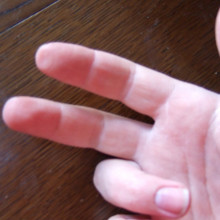
09:33 - Prof James Sharpe - Making fingers
Prof James Sharpe - Making fingers
with Professor James Sharpe, Centre for Genomic Regulation Barcelona
Kat - Most of us are born with five fingers on each hand - but have you ever wondered how they get there? The answer was first put forward more than 60 years ago by mathematician and wartime code-breaker Alan Turing, who published a paper suggesting how molecules can interact to create stripy patterns - including the five stripes of bones that make up our fingers and toes. It's recently become clear that this kind of system is at work in developing limbs, but the exact identities of the biological players involved wasn't known. Now a team of researchers from the Centre for Genomic Regulation in Barcelona think they've found the answer. I asked James Sharpe, who led the work, about how he tracked down these mysterious molecules.
James - So, the main approach was to distinguish between the cells that are going to form your fingers and the cells that are forming the tissue in between your fingers. During early embryogenesis when your hand is forming, the hand is in fact a continuous plate of tissue. And some cells will become fingers and the cells in between these regions will become the gaps between your fingers. Although at these early stages, they're still cells. So, it's a decision between two cell fates, making fingers or making the gaps. The goal was simply to find which molecules show any sign of having an on/off, on/off pattern between these two cell fates as early as possible.
Kat - So you're basically looking for things that are set up in stripes at this very, very early stage?
James - Yes, exactly and they could be genes or proteins that are either expressed or active either in the cells that will become digits or ones that were only active in the cells that will become the gaps. It could be one way or the other. It doesn't really matter.
Kat - So, you tracked down these molecules. How do you know that they are the ones that are responsible for actually making this pattern and telling the fingers to grow there?
James - That's a very good question. The critical thing to do is to somehow make some predictions about what would happen if we manipulated these molecules to the pattern. So, in addition to looking for the molecules, we also built a computer model, a computer simulation of the process based on as much evidence and data as we could get.
With the computer model, we then made predictions about what would happen if you slightly repressed one pathway or the other, what would actually change in the pattern of the fingers. And then finally, we were able to actually test that by taking little pieces of tissue, very small pieces of tissue at less than 1 mm from early mouse embryos and cultured them in a Petri dish and actually applied drugs to reduce one pathway or the other, or both pathways together. And the very satisfying result was to see that when we did these experiments, they actually recapitulated the computer predictions very closely.
Kat - And obviously, it's a really nice thing to know that this is probably what's going on to be able to understand the biological system like that, but is there any way we can take this forward? How can this knowledge be used? Is there any aspect of human health or tissue engineering that could be useful for this?
James - In the long term, understanding how tissues build themselves. It's the only way that we will be able to do proper tissue engineering. What I mean by that is growing tissues in a dish, getting tissues to organise and build themselves so that they are functional tissues or pieces of organs or even hold organs. To be able to do that, we have to understand how the body normally does that. And that's essentially what this work contributes to. Unless we understand all the parts of the story, all the basic principles by which tissues are organised, we will not achieve what must be naturally the long term goal of this work which is to rationally, consciously design tissues in a dish for various kinds regenerative medicine. So, I believe that this is inevitably going in that direction, but it's also clear that it's going to be a long way in the future.
Kat - One of the names that you've mentioned is Alan Turing. Most people think of him as a computer scientist, a mathematician. It's interesting to see that he's actually made such a contribution to understanding of biology even from so far in the past.
James - He was really interested in how complicated and clever machines - let's say - arise in nature in general and this led to his interest in the brain and in artificial intelligence, and how you can calculate things, how you can work things out. But also, to how these amazing machines such as the brain or such as a body in general comes into existence in nature. So, I think that from his interests, these two things were not so different.
Kat - Professor James Sharpe from the Centre for Genomic Regulation in Barcelona. And you can read my feature on Turing patterns in biology for free in the online magazine Mosaic:
http://mosaicscience.com/story/how-zebra-got-its-stripes-alan-turing
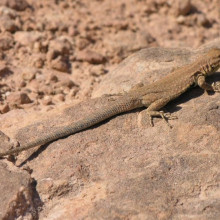
14:38 - How lizards regrow their tails
How lizards regrow their tails
Writing in the journal PLoS ONE, researchers at Arizona State University have analysed the patterns of gene activity in regrowing lizard tails, which could pave the way for better regenerative technology in human tissues in the future.
The scientists were studying the green anole lizard which can escape from predators by simply losing its tail then growing a new one over the next two months. But while lizards share many genes with humans, we don't share their incredible regenerative abilities.
The team discovered that the lizards turn on at least 326 genes in specific regions of the regenerating tail. Some of these are genes embryonic development and wound healing, as might be expected, as well as a biological signalling system called the Wnt pathway, which is also used by other animals that can regenerate their tails, such as salamanders and some fish. The researchers also identified a special type of cell that is important for the lizard's tail regeneration, known as satellite cells, which are also found in humans.
The hope is that understanding the genetic 'recipe' at work in the lizard's tail might lead to new ways to regrow human cartilage, muscle or even spinal cord in the future.
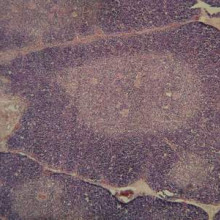
15:49 - Organs in a dish
Organs in a dish
The day when we can grow fully-functioning organs in a dish have come a step closer, as researchers at the University of Edinburgh have managed to create a mouse thymus in the lab - this is the organ responsible for making T-cells in the immune system - and transplant it back into an animal.
Publishing their findings in the journal Nature Cell Biology, the researchers took mouse embryonic cells called fibroblasts, and used a gene called FOXN1 to turn them into thymus cells. When these were mixed with other types of thymus cells and transplanted back into a mouse, the cells organised themselves into a replacement organ that functioned the same as a regular adult thymus. It's the first time that scientists have made an entire living organ from cells that were created outside of the body by reprogramming.
Although the work's currently still at an early stage, the scientists hope that their lab-grown cells could one day form the basis of thymus replacement therapies, or even lead to personalised T-cells grown in the lab to help people with faulty immune responses.
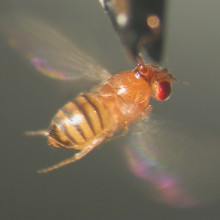
16:58 - Michael Shannack - Fat, old flies
Michael Shannack - Fat, old flies
with Michael Shannack, UCL Institute of Healthy Ageing
Kat - But first, we return to our age-old topic, at the UCL Institute of Healthy Ageing. Student Michael Shannack has been studying fruit flies carrying an altered version of a gene called glycogen synthase kinase 3, or GSK3 for short, which have longer, healthier lifespans than their normal counterparts. He's been trying to find out why.
Michael - So, the flies in this lab live normally the best part of 2 to 3 months. On average, the flies that we were working on with this manipulation of this protein were living about 10-15 % longer than the average fly.
Kat - So, have you translated that to a human that would be living an extra 10 years I guess?
Michael - Yeah, if you took a direct correlation to humans, it would be about 10 years, but of course, a fly is not human. But there are some other promising strategies as well which for example, you've got mice - we've known as maybe 100 years now - mice, if you give them about 60% of what they normally eat, they somehow live 30% longer, so that's quite nice. Obviously, we don't want humans to go starving themselves and there are some people who practice this. It's called calorie restriction. It would be nice to have a pill that does the same thing without having to actually physically starve and cut out things from your diet.
Kat - Because food is nice.
Michael - Absolutely. We love to eat, right?
Kat - Food makes me happy.
Michael - Exactly. We love to eat things that are normally not very good for us as well. So, it would be interesting to see if we could find a way of mimicking this restriction of calories in a way that doesn't actually affect the quality of life.
Kat - What exactly is the protein, the gene that you're looking at that's faulty in these flies?
Michael - So, this protein is called GSK3. It's quite central. It's got a diverse range of things. It controls survival of cells. It actually promotes the survival of cells which is great in one sense, but also, you don't want to...
Kat - You want your cells to live longer if you're going to live longer.
Michael - Exactly. So, if your cells are healthy and living longer then obviously, your organs will live longer and you will live longer. So, that's the idea. Obviously, there's a danger that you don't want to have cells living so long that they're actually replicating uncontrollably and you get into territories of cancer which is not good. On the other hand, the same protein GSK3 also controls cell death. So, it can actually promote what they call the programmed cell death. So, our body has ways of shutting off cells that aren't working very well. Actually, the interesting finding, the main finding of my study was that this is specific to different areas of the flies. So, having more of this protein in certain areas of the fly is worse off and having it in another area of the fly is better off. So, it's very tissue specific.
Kat - What have you discovered about it that makes the flies live longer?
Michael - So, one of the things we were interested in and this is something that's kind of common in ageing research is to try and stress test the things that you're working on. So, you see how do they react to different stresses. It might be in terms of starvation - how do they react to starvation - so, no nutrient at all. Actually, these flies were kind of sensitive to starvation which is interesting. Then we also gave them a different stress in terms of what we call oxidative stress. So oxidative stress is basically in the process of breathing and respiration, producing energy from food basically, you have a by-product, this thing called reactive oxygen species. These are quite nasty chemicals that go out and damage DNA and are generally not very good. We have systems in the body that actually mop these up and kind of prevent the damage.
So, we wanted to see actually, do these flies have some kind of resistance to the stress. So, when we tested it they were actually much more resistant. So, that suggests that there's something going on in the fly - maybe the defence mechanisms, the defence systems against these kind of bad chemicals are actually higher. We haven't done the tests to see whether that's right, but these are suggestive tests.
Kat - So, you know they behave differently to starvation. You know that they have some kind of weird defence against these reactive oxygen species. Obviously, that's in fruit flies. Is there any evidence that these processes might be similar in other organisms as well, or is that for the future to find out?
Michael - Well, we know the calorie restriction or what they call dietary restriction generally, has worked in everything from single-celled yeast, all the way up to the mice for sure and even some studies going on in primates. You could say that it could actually make them healthier. I saw a picture - you can see one is kind of grey and the fur is not very good and it kind of looks a bit wrinkly. The other one has been dietary restricted looks much healthier and they're both the same age. So, this is quite promising. Actually, this whole thing feeds down into what we look at here in this lab which is the way that insulin reacts with our body.
Kat - This is the chemical that helps us process sugar in the body, is it?
Michael - Exactly. So, insulin is produced basically when you eat sugary foods. It helps to take the foods that you eat and store it away for later use. So, you don't want to have too much sugar going around in your blood. We found that if you have less of this insulin going around, then actually, you tend to live longer and healthier. And this works on both worms which is worked on in this lab and also, the fruit flies.
Kat - So, in terms of the story you've been working on trying to put together what's going on in these flies with this particular mutation and why do they live longer, what's next for this particular bit of work?
Michael - Well the next thing, we've done all the - what they called phenotype studies. So, the phenotype is just looking at the behaviour. So, do they live longer? Are they able to climb better? Can they move better with age? So, you kind of study the differences in what you can see. Once you've got those differences you can say, "Okay, I'm going to start looking at this in terms of biochemical studies." So, that means testing - are they fattier than the other flies because we find that when we have mutants to do with insulin, we find they actually are generally fatter than normal flies.
Kat - How do you tell if a fly is fat?
Michael - Well, we have a test where you can test actually how much fat or lipid they have in them.
Kat - In other words, they can't just get off the ground where they're trying to fly.
Michael - Yeah, they kind of just sit there and watch the telly. There are ways - you can do tests to find out how different they are and find out different changes at a genetic level, what's changing. For example, if they have more defence, there are genes that actually protect us against the stresses that we have in our body. You can see if the expression of these genes have changed, you can see if they're higher. That will make sense if they were.
Kat - How long would you want to live for? I mean, you're a master student, you're a young guy. How long do you want to live for?
Michael - The obvious answer is forever, but the point is, you want to live as long as you enjoy the life you're in. So, you wouldn't want to live forever if forever meant living in misery. You want to be able to enjoy the things that you normally enjoy to the extent you do now. So, if I kept enjoying life as much as I do now, then the answer would be forever.
Kat - That was Michael Shannack, from the UCL Institute of Healthy Ageing.
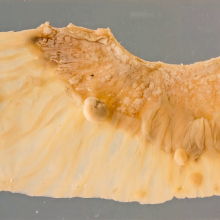
What is the current knowledge of treatments for Von Recklinghausen disease?
Rosalie - A lot has happened since I started being involved in the late 1980s. They found the gene at that time, so they know where the gene is and they found a bit about the function of the gene. The gene product is really this tumour suppressor. So, simply stated, it keeps cells controlled. So, it stops them growing too much and dividing too much. The research has gone into a number of areas. It's gone into learning problems which is one of the commonest manifestations of the condition. It's usually mild learning problems. Research has gone into tumours - both benign and malignant - and it's gone into bone. I think these are sort of the big areas. The two things that are being done, they're looking at underlying molecular mechanisms so that they can target treatment to the particular problem, and they're also looking quite carefully at something that is not quite so buzzy, but very important, which is outcome measures. So, it's no good having a treatment if you don't know how to measure whether it's been beneficial or not. When you look at outcome measures, you want to look at things that are objective have you shrunk the size of something, have you improved intelligence. But importantly, you want the patient's point of view because that doesn't always coincide with what you see as an improvement.
Kat - Have there been significant advances in treatments for these types of tumours and diseases?
Rosalie - Yes, they're starting to come through. I think one always needs to be cautious. So, if you take for instance the benign neurofibromas, the lumps, they cause a lot of problems because they're cosmetically difficult. They can cause neurological problems. They can cause pain and bleeding. They've used mouse models which are very good models for the disease to screen potential drugs that may block these rather complex tumour formation pathways. There have been a few drugs that have been tried with limited success. There was a new drug called a MEK inhibitor. MEK is just one of those signals on the pathway that activates tumour formation. Very early results suggest that they shrink neurofibromas a little. I wouldn't say massively, but a little bit promising. So, the hope is to increase the clinical trials for that. From the point of view of learning, they've tried statins - statins are buzzy for lots of reasons - but it was thought again from the mouse models that statins might help with improving learning. They've done a couple of trials on children and so far, there haven't been huge beneficial results. What this is saying is that it's a huge step forward to understand a bit more of the molecular mechanisms underlying complications. These are early stages in treatment where people are trying to have certain blocking different bits of this very complex pathway. There are treatments available. Are they effective? At this stage, it's quite early to say.
Kat - Thanks to listener Ann Hawke and Professor Rosalie Ferner. If you've got any questions about genes, DNA and genetics, just email them to me at genetics@thenakedscientists.com.

28:30 - Gene of the month - SIRT1
Gene of the month - SIRT1
with Kat Arney
And finally it's time for our gene of the month, and it's SIRT1. One of a family of genes called Sirtuins, SIRT1 is one of seven human versions of genes found across pretty much all organisms from bacteria and yeast upwards.
Sirtuins seem to have a role in a variety of vital processes within cells, many of which are connected to energy production and ageing, as well as stress responses and the body clock. And, as you might expect, they've also been implicated in a range of diseases including Alzheimer's, diabetes and cancer.
Scientists studying ageing are particularly interested in SIRT1 as it can be switched on by chemicals such as resveratrol, found in red wine and red grape juice, and significantly extends lifespan in animals in the lab. Unfortunately, this research doesn't support the idea that necking a bottle of cabernet sauvignon every day will do you much good.
- Previous What makes a good password?
- Next Sex and back pain










Comments
Add a comment